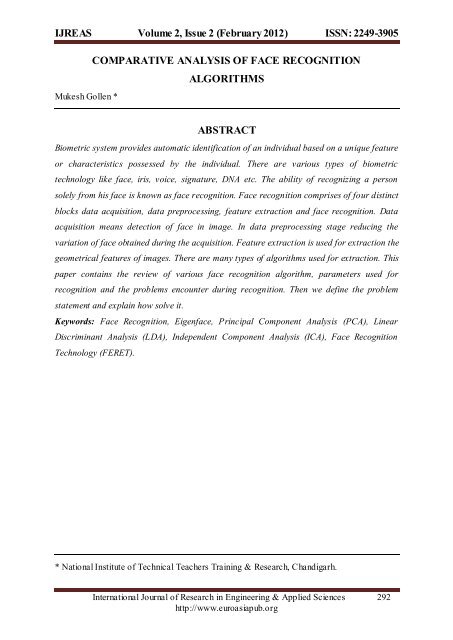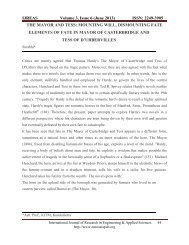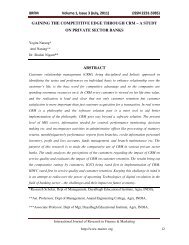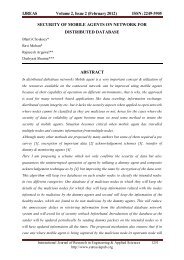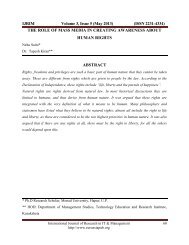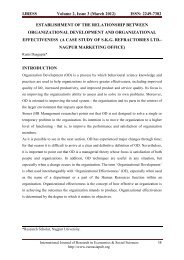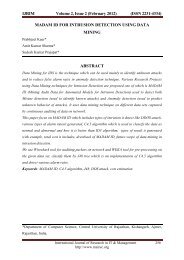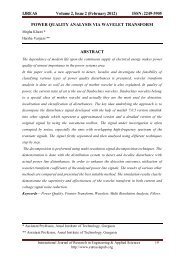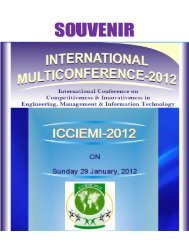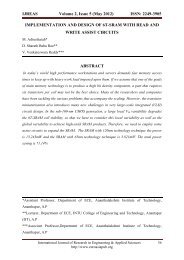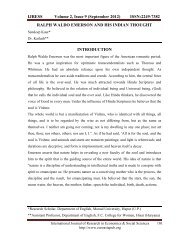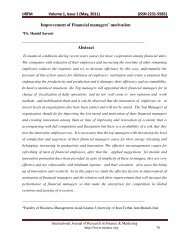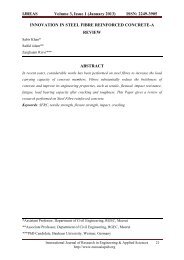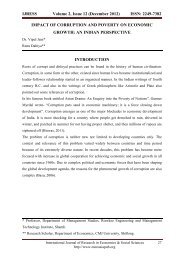comparative analysis of face recognition algorithms - Euroasiapub.org
comparative analysis of face recognition algorithms - Euroasiapub.org
comparative analysis of face recognition algorithms - Euroasiapub.org
You also want an ePaper? Increase the reach of your titles
YUMPU automatically turns print PDFs into web optimized ePapers that Google loves.
IJREAS Volume 2, Issue 2 (February 2012) ISSN: 2249-39052.2 Linear Discriminate AnalysisLinear discriminate <strong>analysis</strong> tries to differentiate between classes rather than trying to presentthe data. Therefore, LDA cares about getting features vectors for class discrimination. Wedefine two scatter matrices [10].M jRjjw i j i jj 1 i 1s x xTsRb j jj 1TThe first is called the within-class scatter matrix while the second is called the between-classmatrix. j denotes the class while i denotes the image number.j is the mean <strong>of</strong> class j whileμ is the mean <strong>of</strong> all classes.Mj is the number <strong>of</strong> images in class j and R is the number <strong>of</strong>classes. The algorithm aims at maximizing the between-class matrix while minimizing thewithin-class matrix. This can be done by maximizing the ratio det | S | / det | S . As withPCA we have a projection matrix G. this matrix is used to maximize the mentioned ratiowhen its columns are eigenvectors <strong>of</strong>[8].1SwSb. A problem arises when wbwS becomes singular2.3 Independent Component AnalysisICA is considered as a generalization <strong>of</strong> PCA. PCA considers image elements as randomvariables with minimized 2 nd order statistics. ICA proposed by minimizes both second-orderand higher order dependencies in the input data and tries to get the basis <strong>of</strong> which the projectdata is statistically independent. Two different approaches are taken by the ICA for <strong>face</strong><strong>recognition</strong>. In first approach images are considered as random variables and pixels as trials.In other words ICA architecture first tries to find a set <strong>of</strong> statistically independent basisimages. In second approach pixels are considered as random variables and images as trials[10].The algorithm works as follows [2].Let X be an n dimensional (n-D) random vector representing a distribution <strong>of</strong> inputs inenvironment.International Journal <strong>of</strong> Research in Engineering & Applied Sciences 295http://www.euroasiapub.<strong>org</strong>
IJREAS Volume 2, Issue 2 (February 2012) ISSN: 2249-3905Let W be an n*n invertible matrix, U=WX and Y=f(U) an n-D random variable representingthe outputs <strong>of</strong> n-neurons. Each component <strong>of</strong> f f1,........., f is an invertible squashing2function, mapping real numbers into the [0,1] interval. Typically the logistics function isused.fiu11eThe U1, U2,......... Unvariables are linear combinations <strong>of</strong> inputs and can be interpreted asinterpreted as presynaptic activations <strong>of</strong> n-neurons.T1' TWWH Y W E Y U3. FINDINGS FROM LITERATURE REVIEWFollowing are the major findings from survey: We found that the most commonly usedparameters for <strong>face</strong> <strong>recognition</strong> are as follows: 1) Accuracy 2)Variability in data size3)Blurriness in test data 4)Image size. In most <strong>of</strong> the <strong>face</strong> <strong>recognition</strong> <strong>algorithms</strong>, the majormathematical technique used is the autocorrelation matrix <strong>of</strong> the <strong>face</strong> image. Theeigenvectors (also known as eigen<strong>face</strong>s) are drawn from the autocorrelation matrix to analyzethe different characteristics <strong>of</strong> <strong>face</strong> image. From literature, We found that the major problemswhich researchers <strong>face</strong> are 1) curse <strong>of</strong> dimensionality 2) semantic gap 3) small sample size.ICA method is generalization <strong>of</strong> PCA method and also these two methods are very commonlyused for most <strong>of</strong> the <strong>face</strong> <strong>recognition</strong> <strong>algorithms</strong>.uFigure 1 shows the small sample size problem in LDA algorithmThe horizontal axis in Fig. 1 represents the number <strong>of</strong> classes used for <strong>recognition</strong>, and thevertical axis represents the corresponding <strong>recognition</strong> rate. The +, ○, ×, signs in fig. 1indicate there were 2, 3, and 6 samples in each class, respectively. The results shown in fig.1reflect that the proposed approach performed fairly well when the size <strong>of</strong> database was small.However, when K (the number <strong>of</strong> class) multiplied the M-1 (the number <strong>of</strong> samples minus 1)International Journal <strong>of</strong> Research in Engineering & Applied Sciences 296http://www.euroasiapub.<strong>org</strong>
IJREAS Volume 2, Issue 2 (February 2012) ISSN: 2249-3905was close to n (the number <strong>of</strong> features <strong>of</strong> class, n=128), the performance droppedsignificantly. The phenomenon was especially true for the case where M=6.Figure 2 Comparison <strong>of</strong> the <strong>face</strong> <strong>recognition</strong> accuracy by different feature extractionmethodsFigure 2 explains the accuracy <strong>of</strong> different feature extraction methods with varying number<strong>of</strong> training samples per class.4. PROBLEM DEFINITIONThe aim <strong>of</strong> current work is to evaluate the <strong>comparative</strong> <strong>analysis</strong> <strong>of</strong> PCA, ICA and LDA for<strong>face</strong> <strong>recognition</strong>. First we implement these <strong>algorithms</strong> and then evaluate the performances <strong>of</strong>these <strong>algorithms</strong> under various parameters and then compare it with other methods. The<strong>analysis</strong> will be done on the following parameters:-Accuracy= ×100Mean Squared Error =PSNR =Total execution time = total time taken for execution <strong>of</strong> algorithmAfter adding noise = Input images corrupted by Gaussian noise.• Accuracy• Total execution timeEffect <strong>of</strong> blurriness level= Input images blurred by a Gaussian filterEffect <strong>of</strong> different image size = S ize means pixel values are different4.1 MethodologyA <strong>face</strong> <strong>recognition</strong> system consists <strong>of</strong> four blocks. First is <strong>face</strong> detection that scans andcaptures a digital or an analog image <strong>of</strong> living personal characteristics. Second is <strong>face</strong>preprocessing which is used to preprocess the image using histogram technique. Third is theInternational Journal <strong>of</strong> Research in Engineering & Applied Sciences 297http://www.euroasiapub.<strong>org</strong>
IJREAS Volume 2, Issue 2 (February 2012) ISSN: 2249-3905feature extraction which extracts the image into vector form thro ugh PCA, LDA and ICAalgorithm. Final step is the feature matching.4.2 Data CollectionThere are a lot <strong>of</strong> databases available at commercial level for research work. The ATT FaceDatabase [7], Indian Face Database (IFD) [8] and FERET database [12]. We choose theFERET database because the FERET database contains images <strong>of</strong> 1,196 individuals, with upto 5 different images captured for each individual. The images are separated into two sets:gallery images and probes images. Gallery images are image with known labels, while probeimages are matched to gallery images for identification.5. Experiment Results and DiscussionAt first we observed the accuracy <strong>of</strong> <strong>face</strong> <strong>recognition</strong> <strong>algorithms</strong> (PCA, LDA, ICA) using theFERET Database and plot the output using the graph.Accuracy PercentageFigure 3 Accuracy <strong>of</strong> PCA, LDA, ICA Face <strong>recognition</strong> algorithmAs shown in Fig. 3 LDA outperforms well from other two <strong>algorithms</strong>. But in PCA and ICAboth performance similar.Total execution timeFigure 4 Total Execution Time for ICA, PCA and LDAAs shown in Fig. 4 ICA execution time is more than the LDA and PCA.International Journal <strong>of</strong> Research in Engineering & Applied Sciences 298http://www.euroasiapub.<strong>org</strong>
IJREAS Volume 2, Issue 2 (February 2012) ISSN: 2249-39057. Jian Yang David Zhang ,Jing-yu Yang,“Is ICA Significantly Better than PCA forFace Recognition”, in 10 th IEEE International Conference on Computer Vision(ICCV’05), pp.1348-1354, 2005.8. Haitao Zhao, Pong Chi Yuen, “Incremental Linear Discriminant Analysis for FaceRecognition”, in IEEE Transactions on Systems, Man, And, Cybernetics , vol.38,No.1, pp.210-221, 2008.9. Neerja, Ekta Walia, “Face <strong>recognition</strong> Using Improved Fast PCA Algorithm”, inIEEE Conference on Image and Signal Processing, pp.554-558, 2008.10. Juwei Lu, Kostantinos N. Plataniotis, Anastasios N. Venetsanopopulos, “FaceRecognition Using LDA-Based Algorithms”, in IEEE Transactions on NeuralNetworks, vol.14, No.1, pp.195-200, 2003.11. M. Turk and A. Pentland, “Eigen<strong>face</strong>s for Recognition”, in Journal <strong>of</strong> CognitiveNeuroscience, vol. 13, no. 1,pp.71-86, 1991.12. P. J. Phillips, H. Moon, S. A. Rizvi, and P. J. Rauss, “The FERET evaluationmethodology for <strong>face</strong>-<strong>recognition</strong> <strong>algorithms</strong>”, in IEEE Transactions on PatternAnalysis and Machine Intelligence, vol. 22, no. 10, pp.1090-1104, 2000.International Journal <strong>of</strong> Research in Engineering & Applied Sciences 300http://www.euroasiapub.<strong>org</strong>


